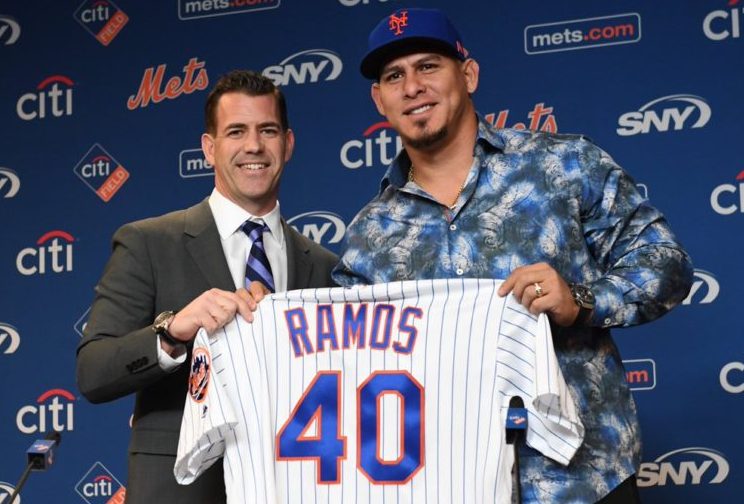
There’s no way around it — general manager Brodie Van Wagenen wasted no time making his mark on the New York Mets’ roster. Outside of the fresh perspective and brash comments about being a playoff team, another big difference in Port St. Lucie is the number of new faces walking around the spring-training complex. Among the places we’ll see these new faces (barring nagging injuries… *cough* Jed Lowrie *cough*) is the every-day lineup.
As a frame of reference, here’s what 2018’s Opening Day lineup looked like against the St. Louis Cardinals:
- Brandon Nimmo, CF
- Yoenis Cespedes, LF
- Jay Bruce, RF
- Asdrubal Cabrera, 2B
- Todd Frazier, 3B
- Adrian Gonzalez, 1B
- Kevin Plawecki, C
- Noah Syndergaard, P
- Amed Rosario, SS
And here’s a look at the projected 2019 starting lineup, via Roster Resource:
- Nimmo, CF
- Lowrie, 3B
- Robinson Cano, 2B
- Wilson Ramos, C
- Michael Conforto, RF
- Frazier, 1B
- Jeff McNeil, LF
- Rosario, SS
This is obviously being conservative and assuming Peter Alonso starts the year at Triple-A Syracuse. Also, the actual order in which Roster Resource has put together here isn’t an exact science and should be taken with a grain of salt.
While Conforto being included in this year’s version is simply because he’s healthy, the three-four-five combination in the heart of New York’s order looks a whole lot different and much more formidable. And if Lowrie does join Nimmo at the top, one can imagine there will be plenty of RBI opportunities for Cano, Ramos, and Scooter — over the past two years, Nimmo owns a .397 on-base percentage, and Lowrie’s checks in at .356.
Although the lack of production in this area of the lineup can’t be pinned solely on the 2018 Opening Day starters, this group in particular struggled. Here’s how each spot ranked in various categories.
| Batting Order | HR (MLB Rank) | RBI (MLB Rank) | OPS (MLB Rank) | wRC+ (MLB Rank) |
|---|---|---|---|---|
| Batting Third | 21 (24th) | 95 (14th) | .770 (17th) | 113 (15th) |
| Batting Fourth | 21 (24th) | 77 (26th) | .645 (30th) | 81 (30th) |
| Batting Fifth | 21 (19th) | 63 (28th) | .706 (24th) | 98 (20th) |
And yes, the home-run numbers also surprised me, but I double- and triple-checked those to make sure my eyes weren’t playing tricks.
The lefty-righty-lefty balance between Cano, Ramos, and Conforto is helpful from a game-planning perspective. However, the microscope will be on this group — Cano and Ramos in particular — because part of the reason BVW brought these guys in was to give the offense the upgrade it so badly needed. Obviously, the beauty of Van Wagenen’s active offseason is that Mickey Callaway can do plenty of mixing and matching if something isn’t working. That can happen on the field and on the lineup card, which one would imagine will be beneficial to the second-year skipper.
If this group experiences success in 2019, the tickle-down effect becomes that much greater, too. Instead of needing to be the middle-of-the-order basher he doesn’t appear to be anymore, Frazier can provide depth at the bottom of the lineup. The same goes with McNeil and Rosario — they can use their respective strong finishes to 2018 as the foundation to keep the ball rolling this upcoming season, all without the pressure of needing to be the part that makes or breaks the offense.
It’s not as if there aren’t some questions each new acquisition will need to answer with their on-field play, either. Cano ended up having a great year thanks to an .845 OPS, 136 wRC+, and 2.9 fWAR, but he’s entering his age-36 season, only played in 80 games last season, and is still fresh off a PED suspension. On the other hand, Ramos has appeared in more than 110 games in a season just three times since debuting in 2010. He’s the upgrade they needed at catcher and in the lineup, but we may be seeing more of Travis d’Arnaud than some would like.
Is it ground-breaking news that a team needs the middle of its lineup to perform in order to have a successful offense? Well, no, of course not, but it has seemingly escaped the Mets more often than not — it hasn’t actually felt like baseball season in recent years until New York’s lineup goes absolutely ice cold at the plate for a prolonged stretch. Pairing proven performers like Cano and Ramos with Conforto appears as though it’ll give the offense a major boost, which was badly needed after scoring more runs (676) than only eight big-league teams in 2018.
While BVW did some work in reshaping the Mets’ bullpen, how the lineup eventually performs at the plate will be much more intriguing to follow, in my eyes. The players taking up residence in the middle of it will have a significant say in whether this unit is an overall success or failure.
















